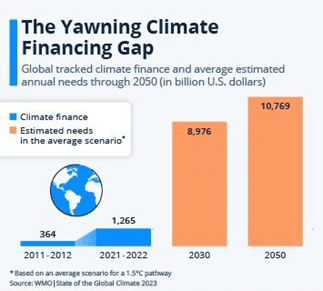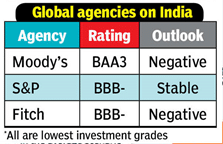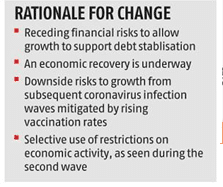TAXONOMY FOR CLIMATE FINANCE WILL PUT INDIAN STANDARDS ON A GLOBAL PLATFORM
Relevance: GS – 3 – Indian Economy and issues relating to planning, mobilization, of resources, growth, development and employment; Climate Finance; Conservation, environmental pollution and degradation, environmental impact assessment.
Why in the news?
- India’s plans to develop a taxonomy for classifying climate finance aim to highlight relevant agendas and present Indian standards globally, according to Ajay Seth, Secretary of the Finance Ministry’s Department of Economic Affairs.
- The government’s approach to developing the climate finance taxonomy.
- Strategies to improve India’s sovereign credit ratings.
- Efforts to recalibrate the infrastructure financing framework.
- Simplifying overseas investment routes for foreign investors.
India’s Climate Finance Taxonomy
- India’s high population and per capita income contrast with countries having smaller populations and higher per capita incomes (over $50,000).
- The dynamics of climate finance will differ for India compared to such countries.
- The planned standards for classifying climate finance will address these unique dynamics.
- Standards and Disclosures:
- Standards will require disclosures on both investment-related and usage-related issues.
- Decisions and guidelines will need to be provided to address these issues.
- Finance Minister Budget Speech:
- Announced the development of a taxonomy for climate finance.
- The goal is to enhance the availability of capital for climate adaptation and mitigation. This initiative will support India’s climate commitments and green transition.
- Climate Finance Taxonomy Objectives:
- To identify assets, activities, and projects necessary for a low-carbon economy.
- Ensure alignment with the Paris Agreement’s goals on mitigation, adaptation, and finance commitments.
Improving India’s Credit Rating
- Government Efforts:
- The government is in regular talks with credit rating agencies to push for better ratings based on the Indian economy’s strength.
- Post-pandemic, India’s economic health has seen significant improvement.
- Current Ratings:
- Sovereign credit rating measures a government’s ability to repay its debt.
- Higher ratings lead to greater trust and lower borrowing costs.
- India’s current ratings:
- S&P and Fitch rate at BBB-
- Moody’s at Baa3 (lowest possible investment grade).
- In May, S&P Global raised India’s outlook to positive from stable after 14 years, sparking hopes for a ratings upgrade.
- Future Plans and Goals:
- The next goal is a ratings upgrade.
- The government aims to manage debt sustainably, ensuring fiscal policy space for future crises.
- The focus is on inclusive, fast-paced economic growth.
- The potential exists to sustain high debt long-term, but not at the current level of 56%.
- Central government’s debt stood at just over 56% of GDP at the end of FY24, down from 57.1% at the end of March 2023.
Committee on Infrastructure Financing Framework
- Headed by Bibek Debroy, Chairman of the PM-EAC, with Ajay Seth as a member.
- It conducted a comprehensive assessment of the characteristics and parameters defining the infrastructure financing framework.
- The final report from the Debroy-led committee is expected this year.
- Focus:
- Evaluating the approach for public versus private financing.
- Exploring ways to incentivize private sector investment.
- Preparing a framework for infrastructure financing under both public and private setups. Developing broad approaches for various sectors including roads, railways, and ports.
Easing FDI Rules
- Upcoming Changes:
- Expected easing of overseas investment rules within the next three months.
- Aimed at simplifying investment norms for foreign portfolio investors (FPIs) and overseas arms of Indian companies.
- Current Regulations:
- Most sectors already allow 100% FDI under the automatic route.
- The inflow of capital regulated under FEMA (Foreign Exchange Management Act) includes complex rules and regulations.
- Proposed Simplifications:
- Discussions ongoing with RBI and SEBI, with common grounds found.
- Simplified rules to be notified by the government.
- Regulatory changes to be implemented by the respective authorities.
- Specific Changes:
- Currently, FPIs can hold up to 10% of stocks in an Indian company.
- Beyond this, shareholding must be diluted or reclassified as foreign direct investment (FDI) with additional compliance.
- Lack of norms for investments by overseas companies of Indian entities in India without parent linkages will be addressed.
Way Forward
- Climate Finance Taxonomy:
- Develop and implement clear standards and disclosures for classifying climate finance.
- Ensure alignment with the Paris Agreement’s goals on mitigation, adaptation, and finance.
- Promote transparency and accountability in climate-related investments.
- Improving Sovereign Credit Ratings:
- Maintain regular dialogue with credit rating agencies to highlight economic improvements.
- Implement fiscal policies to manage debt sustainably.
- Focus on inclusive and fast-paced economic growth to support higher ratings.
- Infrastructure Financing Framework:
- Finalize and implement the comprehensive framework developed by the Debroy-led committee.
- Balance public and private financing approaches for different infrastructure sectors.
- Incentivize private sector investment through policy and regulatory reforms.
- Easing FDI Rules:
- Simplify regulations under FEMA to facilitate easier capital inflow.
- Finalize and notify changes in FDI rules in consultation with RBI and SEBI.
- Establish norms for investment by overseas arms of Indian companies without parent linkages.
- Streamline compliance processes for FPIs to enhance investment attractiveness.
Alternative articles
https://universalinstitutions.com/climate-finance-a-hard-fact-amidst-shifting-commitments/
https://universalinstitutions.com/climate-financing/
https://universalinstitutions.com/financing-indias-green-future/
Mains question
Discuss the implications of India’s plans to develop a climate finance taxonomy. Explain what is the effect of easing FDI rules on the country’s economic growth and sustainable development. (250 words)






